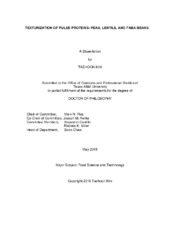| dc.description.abstract | As interest in alternate sources for meat has increased, pulses have gained attention due to their excellent nutritional profile and few concerns about allergens, gluten, and genetically modified organism issues. The objective of this study was to develop texturized pulse proteins (TPP) and high moisture meat analogs (HMMA) with a twin-screw extruder (TX-52) using pea proteins (PP), lentil proteins (LP), and faba bean proteins (FP) and conduct sensory evaluations with patties containing these products. Commercial PP (55.4% protein), LP (55.4% protein), and FP (61.5% protein) were prepared for production of TPP and HMMA. Soy concentrate (SC, 75.8% protein) was used as a control.
Initially, these pulse proteins (PLP) were extruded to produce TPP using a processing condition of texturized SC. However, they were not texturized as well as did soy. High shear configuration was then applied for the TPP with calcium hydroxide (CH), sodium bisulfite, xanthan gum, and pea isolates (PI). Compared to control, texturized FP had significantly higher water holding capacity (WHC), less brown color, and similar gumminess. CH decreased WSI and increased gumminess in texturized LP, and the addition of PI decreased WSI and improved gumminess. 30% of each TPP were formulated to make meat patties with a beef flavor, and consumer evaluation was conducted. They had similar cooked appearance, overall, flavor, and texture except texturized LP (lower overall and texture) and FP (lower overall and flavor).
Premixed recipes (PLP, PI, wheat gluten, and canola oil) were texturized, followed by cooling in a media, freezing, thawing, and rehydration. The control had the best-defined fiber orientation. HMMA containing PLP had significantly different parameters (less lightness, yellowness, M.C., and texture and higher redness and WSI) compared to control. Trained panelists observed higher bean-like, salty, sweet, umami, heated-oil and cohesiveness of mass and less soy, green, cardboardy, musty earthy, salty, hardness, and springiness than control. Consumer panelists gave similar scores on vegetable patties containing PL in cooked appearance, overall, and but lower overall texture.
Our findings suggest that PLP can be used in TPP and HMMA as alternative meat sources, and consumers will have more options for choosing alternative products. | en |


